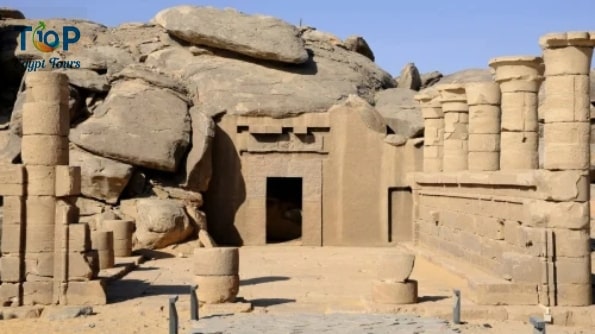The Temple of Beit El Wali: A Gateway to Ancient Nubian Majesty
Temple of Beit El Wali Nestled in the historic region of Old Nubia, the Temple of Beit El Wali stands as a testament to the architectural brilliance and cultural significance of ancient Egypt’s New Kingdom. This remarkable temple complex, also known as Ramses II Temple, offers visitors a captivating glimpse into the grandeur and religious devotion of one of Egypt’s most revered pharaohs. With its historical importance, architectural splendor, and connection to the rich tapestry of ancient Nubian civilization, the Temple of Beit El Wali is a captivating attraction in Old Nubia.
In this article, we will uncover for you theTemple of Beit El Wali with Top Ten Egypt
Architectural Splendor:
The Temple of Beit El Wali showcases impressive architectural features that reflect the mastery of ancient Egyptian craftsmanship. Built during the reign of Ramses II, the temple’s massive sandstone walls, towering columns, and intricate reliefs are a testament to the skill and artistry of the time. As visitors approach, they are greeted by the temple’s façade adorned with colossal statues of Ramses II, creating a striking entrance that transports them into the majestic world of ancient Egypt.
Historical Significance:
The Temple of Beit El Wali holds immense historical and cultural significance. Dedicated to the Nubian god Amun-Re, it served as a religious center and a political statement of Egypt’s dominion over Nubia. The temple’s inscriptions and reliefs depict Ramses II’s military campaigns, religious rituals, and scenes of daily life, providing invaluable insights into the pharaoh’s reign and the cultural exchange between Egypt and Nubia during that era. It stands as a testament to the enduring bond between these two ancient civilizations.
Cultural Heritage Preservation:
The preservation of the Beit El Wali is a testament to Egypt’s commitment to safeguarding its cultural heritage. With the construction of the Aswan High Dam and the subsequent creation of Lake Nasser, the temple faced the risk of being submerged. However, a multinational effort led to its relocation to higher ground, ensuring the protection and preservation of this architectural treasure for future generations to appreciate and study. The temple’s survival is a testament to the importance placed on preserving history and cultural identity.
Artistic Treasures:
Within the Temple of Beit El Wali, visitors can marvel at the exquisite reliefs and carvings that adorn the walls and columns. The temple’s artwork depicts religious scenes, deities, and the pharaoh’s military triumphs, showcasing the artistic prowess and attention to detail of ancient Egyptian artisans. The intricate hieroglyphics and vivid colors on the temple’s walls offer a window into the religious beliefs, cultural practices, and historical events of the time, providing a visual narrative of ancient Egyptian civilization.
Cultural Experience and Connection:
Exploring the Temple of Beit El Wali provides visitors with a unique opportunity to connect with the ancient Nubian civilization and its influence on Egypt. The temple’s location in Old Nubia, with its desert landscapes and remnants of other ancient structures nearby, adds to the sense of exploration and discovery. Visitors can immerse themselves in the history and ambiance of the site, gaining a deeper appreciation for the cultural exchange and shared heritage between Egypt and Nubia. It is a journey that deepens the connection with the enduring legacy of Ramses II and the remarkable civilizations that shaped the region.
The Temple of Beit El Wali, also known as Ramses II Temple, stands as a gateway to the architectural splendor, historical significance, and cultural richness of ancient Egypt’s New Kingdom. With its captivating design, historical importance, and connection to the ancient Nubian civilization, the temple complex offers visitors a remarkable journey into the past. As they explore its grandeur, marvel at its artistic treasures, and embrace the cultural heritage of Old Nubia, visitors are transported to a bygone era, deepening their connection with the enduring legacy of Ramses II and the remarkable civilizations that shaped the region.



Comment (0)